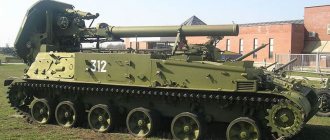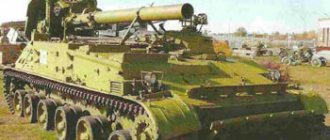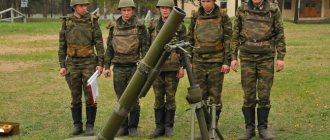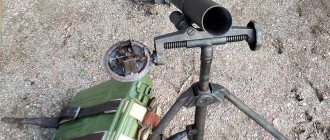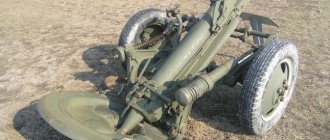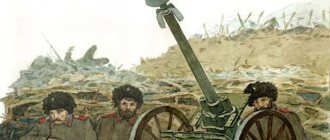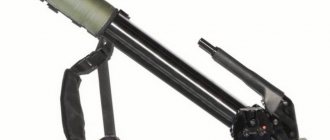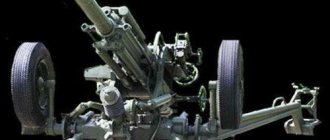Under the conditions of the Cold War and the accompanying arms race, domestic designers created a huge number of weapons of various types, progressive for their time, for the Soviet army. Among them there were also unique samples that had no, and still do not have, analogues in the world.
An example of the highest engineering thought is the 2S4 “Tulpan” - a 240mm self-propelled mortar, which is the only self-propelled gun with a mortar gun of such a large caliber in the world.
History of creation
The leadership of the Soviet Army became interested in mortars as promising means of fire support back in the 30s. Their undeniable advantages were ease of use and maintenance, as well as the absence of serious material costs in its production.
And if mortar guns of relatively small caliber (50mm, 82mm, 120mm) were quickly developed and adopted by the Red Army, then with mortars of 160 and 240mm caliber everything was not so simple. Samples from the first, to the proper condition necessary for adoption, of 160 mm caliber were brought to 1943. Work on the 240mm gun was delayed.
Given the difficult situation in the country in the first post-war years, the development of the mortar had to be interrupted for a short time.
It resumed 2 years later - in 1947. By 1950, the gun was completed, successfully passed field tests and was adopted by the Army of the Soviet Union under the designation M-240. It was he who became the ancestor of the self-propelled mortar gun.
An analysis of the results of the Great Patriotic War showed the Soviet command the advantage of using self-propelled artillery, which led to the creation of a special program for the development of this type of weapon in 1947-1953. However, the rise to power of Nikita Sergeevich Khrushchev put an end to it - all research was frozen.
The new First Secretary of the CPSU Central Committee relied on the missile program and the use of nuclear weapons. With the resignation of Khrushchev, the opportunity arose to resume the interrupted work.
This was also facilitated by the realization of the futility of exchanging nuclear strikes, due to the theoretical complete destruction of both sides in this case, and the high probability of local conflicts, where self-propelled artillery would play an important role. An example of this was the Vietnam War. It also showed the serious lag of the Union in this direction.
Active development phase
The year 1965 was a turning point in the history of Soviet self-propelled artillery. It was then that the development program for the corresponding weapons was approved. It provided for the creation of entire complexes that would include both self-propelled guns and command post vehicles (command and staff vehicles), since it is in this combination that their actions are most effective.
The development of a new self-propelled mortar with a caliber of 240mm was entrusted in 1966 to the experimental design bureau No. 3 at UZTM, the chief designer of which was Efimov G.S.
In parallel with it, ROC is also developing a new 152mm howitzer, which later received the name 2S3 “Akatsiya”. That is why these two self-propelled guns were initially developed on an identical chassis.
It should be said that the Ural Transport Engineering Plant was engaged exclusively in creating the chassis for the new “self-propelled gun”; the weapon itself, based on the already mentioned M-240, was developed by the Perm Machine-Building Plant.
This part was assigned to the SKB under the leadership of Yu.N. Kalachnikov. The mortar they created received the designation 2B8. In a new government decree of 1967, the new car received the designation “Tulip”, and the GRAU index was 2С4.
On the way to "Tulip"
The production of M-240 mortars was carried out at plant No. 75 (Yurga, Kemerovo region), where from 1951 to 1958. produced 329 such products. M-240 mortars were supplied to Czechoslovakia, Poland, Bulgaria, Egypt, and Syria. However, their active service in the Soviet Army was relatively short-lived. The large-scale introduction of the M-240 coincided with the beginning of Khrushchev's reforms in the armed forces. These measures, which led to a significant reduction in the number of personnel, the fleet of combat aircraft, and large surface combatants, are usually assessed negatively: “Khrushchev ruined everything.” However, in our opinion, only thanks to the achieved cost savings it was possible to achieve a breakthrough in the field of rocket technology and launch the mass construction of a nuclear submarine fleet. In other words, the USSR economy simply could not tolerate the simultaneous development of all types of weapons, so it was necessary to sacrifice some of them in favor of more strategically important ones. Barrel artillery was also among those sacrificed - it was believed that a significant part of the tasks assigned to it would be carried out by tactical missiles.
Self-propelled mortar 2S4 "Tulip"
The bet on missiles was justified only in one case - if we focus on a nuclear war. However, it soon became clear that such a war was extremely unlikely, since it was guaranteed to lead to the destruction of both sides of the conflict. But in a normal conflict, artillery could be much more useful than expensive and bulky missiles. Calculations carried out in 1964 showed that the use of self-propelled artillery in combination with command and staff vehicles makes it possible to significantly reduce the time it takes to complete combat missions, while at the same time significantly reducing the number of forces involved. But in the USSR during the post-war period not a single new self-propelled artillery weapon was adopted, while in the USA by the beginning of the 60s. the second generation of such systems was already created (105 mm howitzer M108, 155 mm M109, 203.2 mm M110, as well as the 175 mm M107 gun), and self-propelled guns of the first post-war generation (105 mm howitzer M52, 155 mm M44 and 203.2 mm M55) were transferred to the allies.
Exercises conducted at the Yavorovsky training ground (Lvov region) involving self-propelled artillery - self-propelled guns ISU-152 and SU-100 - confirmed the correctness of the conclusions of military theorists about the benefits of self-propelled guns. And just then the first information began to arrive about the successful use of new generation self-propelled guns by the Americans in Vietnam. Against this background, to put it mildly, the Soviet self-propelled guns, which still remembered the Second World War, looked pale. The report on the Yavorov exercises spoke of the need to create new self-propelled artillery installations with all-round firing, large barrel elevation angles, increased transportable ammunition and an increased rate of fire. Representatives of industry were also present at the exercises - the chief designers of three specialized design bureaus: the Volgograd Tractor Plant, Plant No. 9 from Sverdlovsk (now Yekaterinburg) and OKB-3 of the Ural Transport Engineering Plant (also from Sverdlovsk).
The response to the challenge of the time was the approval by the Council of Ministers of the USSR in 1965 of a program for the development of artillery weapons, which provided for the development of complexes consisting of command and staff vehicles and self-propelled artillery guns. And in July 1967, a decree was issued by the Central Committee of the CPSU and the Council of Ministers of the USSR, which specified this program and identified the developers of four types of self-propelled guns. In particular, the Kharkov Tractor Plant was entrusted with the creation of a 122-mm self-propelled howitzer 2S1 "Gvozdika" for motorized rifle units, the Volgograd Tractor Plant - the 2S2 "Violet" system of a similar caliber, but intended for airborne troops (ultimately it was not adopted for service) was). Finally, the Ural Transport Engineering Plant (UZTM) was entrusted with the development of two installations at once - the 152-mm self-propelled howitzer 2S3 "Akatsiya" and the 240-mm self-propelled mortar 2S4 "Tulip".
Self-propelled mortar 2S4 "Tulip"
Testing and serial production
The creation of prototypes of a self-propelled mortar gun was completed in 1969. After successful factory tests, a decision was made: to send the vehicles for field testing. Moreover, the first firing could not be called successful - the design of the connection between the gun and the chassis could not withstand the recoil, as a result of which the fuel tanks were damaged.
Improvements to the 2S4 “Tulpan” continued until 1971, when the “self-propelled gun” was adopted by the Soviet Army.
The main tasks of a self-propelled mortar were the destruction of fortified or fortified structures of the enemy, his manpower, armored and motorized vehicles. Also, the use of 2S4 was implied in situations of insufficient effectiveness of artillery guns of a different type or smaller caliber.
The self-propelled mortar was mass-produced from 1972 to 1988. Moreover, in the early years, the order of the Ministry of Defense was only four vehicles per year. One of the main reasons for this situation was the high cost of production of Tulip.
If we compare it with the 2S3 Akatsiya self-propelled howitzer, which uses a similar chassis, the cost of the 2S4 was at least 6 times higher - 36.5 and 210 thousand Soviet rubles, respectively. During the entire production period, 588 cars were created.
Design
Despite the fact that the self-propelled gun was developed back in the 60s, its design, taking into account some modifications, still allows the Tulip to be positioned as an effective and multifunctional means of supporting ground forces.
For the 2S4, it was planned to use a tracked chassis, developed at the same Ural Transport Engineering Plant in the early 60s for the Krug air defense system. It, in turn, is a modified version of the SU-100P self-propelled gun chassis, whose production was completed in 1959.
However, the power of the power plant of this model (400 hp) was sorely insufficient for the tasks of self-propelled artillery. This led to her replacing the engine with the V-59U with 520 hp. One of its advantages is the ability to work on both diesel fuel and kerosene.
An increase in the power of the power plant led to the need to modernize other chassis components, which ultimately led to the replacement of more than 75% of its components.
The chassis has an individual torsion bar suspension. The drive wheels are located at the front, and the guides, respectively, at the rear. The maximum speed on the highway is about 60 km/h, on rough terrain about 35 km/h. The maximum possible speed in reverse gear is 14 km/h.
Frame
The Tulip hull does not have a turret. The vehicle came with an open installation of an artillery gun. Reservations are provided by hot-rolled armor plates, which protect the crew from being hit by armor-piercing bullets of 7.62 caliber and fragmentation shells.
The rather low security of the vehicle is due to the use of the 2S4 as a support weapon, working in the rear of friendly troops, and not in an open clash with the enemy. The hull is equipped with a bulldozer blade in the bow, intended for independent arrangement of a long-term firing point. The gun base plate is attached to the rear armor plate.
The internal space of the case is divided into three sections:
- combat;
- power (motor);
- management department.
The latter is located in the left front part of the body. Here are the seats of the driver and commander of the vehicle. Above the commander's chair there is a tilting hatch with a rotating turret equipped with surveillance and communication devices. To the right of the control compartment is the engine compartment, where, in fact, the power plant is mounted.
The rest of the vehicle's space is occupied by the fighting compartment. The middle part is given over to ammunition storage, which is a mechanized storage of a drum structure. Here, on the sides, there are also seats for the rest of the vehicle’s crew: one camera operator on each side and a gunner’s seat in the rear right side of the compartment. At the stern of the self-propelled gun, the designers placed two fuel tanks.
On the upper part of the stern there are special hinged beams, to which the gun system is directly attached. It can be in two positions - traveling and combat. In the first case, the mortar along with the base plate is folded on the roof of the vehicle. In the second, the mortar tube and, accordingly, the base plate are tilted back using hydraulics until the latter rests firmly on the ground.
Mortars. Self-propelled mortar 2S4 "Tulip". The best…
We paid quite a lot of attention to the history of the development of mortars.
Whatever one may say, today this type of weapon is one of the most deadly. Not potentially deadly, like nuclear weapons, for example, but actually deadly. It is no exaggeration to say that mortar fire claims a life or lives every day. Finishing this material about conventional mortars and moving on to jet mortars, we cannot help but tell and show the very best. Mortar.
Our hero truly inspires respect and fear with his own power in everyone who has at least once seen the results of his work. A mortar that is capable of destroying almost any fortification. A mortar that can fire high explosive, cluster, guided, incendiary, neutron and nuclear mines.
Even, quite possibly, some other ammunition unknown to us.
Today we will talk about a beautiful spring flower that men give to their loved ones in the spring. On March 8th.
We're talking about a tulip. More precisely, about “Tulip”. About the self-propelled mortar of the artillery of the Reserve of the Supreme High Command 2S4 “Tulip” of 240 mm caliber. Designed to destroy fortified buildings, fortifications, concentrations of enemy personnel and armored vehicles, as well as the destruction of objects that, due to their high security, cannot be destroyed by smaller-caliber artillery.
When you see a crater with a diameter of 10 meters and a depth of almost 6 meters, you really understand that this is a Weapon! And this is not some special ammunition. This is an ordinary mine. And what comes to mind is an approximate view of a funnel when working with special mines... And the results of this work for the enemy...
Where did this weapon miracle come from? And it appeared from the logic of the development of the Red Army back in 1938! It was then that a promising program for introducing mortars into the Red Army was adopted. From a rifle company to the High Command Reserve.
The difficulty of working on the RGK mortar was that the large (240 mm) caliber required completely new solutions even in such seemingly obvious things as aiming the mortar at the target or loading. Agree, a 16-kilogram mine for a 120-mm mortar can be loaded in the traditional way. What about a 130-kilogram 240 mm mine? Yes to a height of more than 5 meters?
There was another difficulty. Purely practical. The war required the speedy production of not large-caliber mortars, but battalion and regimental level mortars. 82 mm and 120 mm. This is exactly the task that Headquarters set for the designers. A problem that was successfully solved. What we wrote about in previous articles. And it was solved in many ways by the brilliant Soviet designer Boris Shavyrin.
For five years our designers tried to create a super-powerful mortar. By 1943, two prototypes of 240 mm mortars were even created. But during testing, these mortars turned out to be unsuitable for use. To put it bluntly, the mortar tests were completely failed.
And then the design and creation of a 240-mm mortar was entrusted to Boris Shavyrin. By this time he was the head of the Kolomna Special Design Bureau of Smoothbore Artillery (SKB GA). The famous designer abandoned the already used schemes and started work almost from scratch. Imagine, work began in January 1944 and in the same year factory tests of the new mortar began!
At the end of the war, the country's leadership became convinced that there was no urgent need for a 240-mm mortar, and work was stopped. But in 1947 they returned to the topic. The Shavyrin mortar was sent for state tests. In 1950, this mortar was adopted for service under the name M-240.
Unfortunately, production of this mortar was stopped in 1958. The reason is the same as for other representatives of barrel artillery. The then head of state N. Khrushchev considered that such weapons were futile, and the future lay with missiles. A total of 329 mortars were produced at plant No. 75 in the city of Yurga, Kemerovo region.
But the M-240 still found its war. In 1985 in Afghanistan. In the fall of 1984, the howitzer battery of the 1074th artillery regiment of the 108th motorized rifle division was rearmed with 4 M-240 mortars. The soldiers and officers of the battery were retrained in the Union. The first combat use of the M-240 and the Daredevil mine was in the Charikar Valley area. Subsequently, M-240s were in the Panjshir gorge, beating the spirits of Akhmat Shah Massoud. The effectiveness of the mortar was amazing. One, maximum two shots to destroy the target!
What is the M-240? It is simply necessary to take a close look at this mortar. The fact is that it is the modification of this mortar under the designation 2B8 that makes up the artillery part of our “spring flower” - “Tulip”.
The 240-mm M-240 mortar is a rigid structure (without recoil devices) on a wheeled carriage. It consists of the following parts: a barrel with a bolt, a frame with a shock absorber, a machine with guidance mechanisms, a balancing mechanism, a boom with a mechanism for transferring the mortar from the traveling position to the combat position and back, a base plate, a pin and sighting devices. The barrel has the shape of a smooth-walled pipe, fixed in trunnion holders. Thanks to this, it is able to swing on the axles to bring it into position for loading.
Mortar with breech-loading loading circuit. When loading, the mortar barrel “breaks”. The breech is used to close the barrel and transfer the recoil force to the base plate. Its conical part ends with a ball heel, with which the breech is connected to the base plate bowl.
The machine consists of two frames (upper and lower) of a stamped-welded structure, hingedly connected to each other. The rotary mechanism is screw, allowing for horizontal guidance without moving the wheels. Since the recoil force is quite significant, and the mortar does not have recoil devices, shooting at elevation angles of more than 45° is allowed only from hard ground and after several “shrinkage” shots.
Screw type lifting mechanism. The balancing mechanism is spring-loaded and located on the right side of the machine. The lower frame is assembled on the combat axle of an inseparable wheel drive.
The wheels are spring-loaded. The wheels themselves are of the YATB-4 trolleybus type, with a sponge filler. The M-240 is normally towed by the AT-L tracked tractor, but other tractors, as well as Ural and KamAZ trucks, can also be used.
To transport mines to the firing position, the mortar kit included a special single-axle trolley. Loading the mortar required a number of manipulations: - the barrel is brought to a horizontal position; — after opening the shutter, a tray is hung on the half-axis of the shutter wedge; - five crew members manually lift the mine from the cart, place it on the tray and send it into the barrel; - the tray is removed, then the barrel is lowered into the breech to fire a shot.
Main performance characteristics of the mortar:
Weight, kg in combat position: 3610 in stowed position: 4230
Dimensions: length, mm: 6510 barrel length, mm: 5340 width, mm: 2430 height, mm: 2210
Crew, people: 11
Elevation angle, degrees: +45….+80
Rotation angle, degrees at elevation 45: 16.5 at elevation 80: 78
Rate of fire, rds/min: 1
Firing range, m: for F864: 800-9650 for 3F2: 19690
But how did “Tulip” appear? Believe it or not, the appearance of this handsome man was caused by... the Americans! More precisely, the use by the Americans of their self-propelled guns in Vietnam. Unlike us, the Americans understood perfectly well that a global war was possible purely theoretically. But regional wars are a real thing. That’s why they developed their own self-propelled guns. And Vietnam became the testing ground where these machines showed their effectiveness and necessity.
The fleet of Soviet cars of this class looked very pale against the Western background. Self-propelled guns from the Great Patriotic War were really not comparable to new vehicles. Even those that were on the list of the best. ISU-152 or SAU-100 by that time were already inferior to American systems in many respects. And we, according to the old Russian tradition, “rushed to catch up” with the West.
In July 1967, a decree was issued by the Central Committee of the CPSU and the Council of Ministers of the USSR on the development of new self-propelled artillery systems for the Soviet army. The complexes were supposed to include not only the self-propelled guns themselves, but also the CV guns. Several factories were required to develop and submit new systems for state testing.
It was this program that included the self-propelled heavy mortar. The development of this weapon was entrusted to the Ural Transport Engineering Plant in Sverdlovsk. But, realizing that Uraltransmash was unable to completely solve the task on its own, the development of the artillery part of the mortar was entrusted to the Design Bureau of the Perm Machine-Building Plant, which specialized in artillery systems.
Thus, “Tulip” has two “dads” at once. Chief designer of the chassis G.S. Efimov and chief designer of the 2B8 mortar Yu.N. Kalachnikov.
Georgy Sergeevich Efimov
Yuri Nikolaevich Kalachnikov
First, about the chassis. The basis was taken from the chassis developed for the 2K11 Krug air defense system in 1955-56. However, already during the design process, it turned out that the chassis for the heavy mortar was “rather weak.” Starting with engine power (400 hp) and ending with the chassis design itself.
As a result, no more than 20% of the components and mechanisms remained from the “original” chassis in the final version. The rest were modified to meet the specific requirements of the Tulip and the Akatsiya howitzer, which the plant was working on in parallel.
A V-59U engine with a power of 520 hp was installed. s., which provided speeds of up to 63 km/h and a range of 500 km.
The car body was made welded. With protection against armor-piercing bullets of 7.62 mm caliber and shrapnel. A bulldozer blade was installed in front to equip the position.
Functionally, the body is divided into three parts.
The control compartment is traditional for armored vehicles, to the left in front of the center of the hull. The engine compartment is on the right. The middle and rear parts of the hull are given over to the fighting compartment.
In the center there is ammunition in a mechanized drum-type ammunition rack for 20 minutes and a mine feeding mechanism.
In the middle part there is a hatch for supplying mines during loading. There are hatches on the sides for crew landing. The mortar itself is attached to the rear of the hull.
The 2B8 mortar itself is not very different from the M-240. With the exception of the use of hydraulics that has become possible in the “machine version”. Now vertical guidance is provided by a hydraulic mechanism, and horizontal guidance is manual.
Hydraulics also ensure the transfer of the mortar from the traveling position to the combat position and back, bringing the barrel to the mine dispensing line, opening the bolt, feeding the mine from the mechanized ammunition rack to the rammer guides (located on top of the vehicle body), loading the mortar, closing the bolt and lowering the barrel into the breech.
It should be noted that the birth of “Tulip” was difficult. In factory tests, the first three prototypes showed quite good results. But during state tests in 1969, an incident occurred during the production of shots.
The first experimental model at the Rzhevka training ground withstood only two shots. The fastening of the support plate, which rigidly connected it to the body of the machine, burst. And the dynamic wave crushed the fuel tanks like an accordion. We had to urgently change the fastening design.
This did not prevent the RVK 2S4 “Tulpan” 240-mm self-propelled artillery mortar from being put into service in 1971. And already in 1972, the company received an order for the production of the first 4 machines. In total, until 1988, when production stopped, approximately 588 Tulips were produced. We specifically use the word “approximately” since the amount varies somewhat in different sources.
Speaking about the Tulip, we cannot ignore the topic of the ammunition used by the complex. Naturally, such weapons could not be used only for firing conventional, classic ammunition. When talking about the M-240, we mentioned the weight of a regular mine for this mortar. Just over 130 kilograms. But the firing range of such mines is less than 10 kilometers.
A special active-reactive mine 3F2 was developed for the Tulip. Ammunition equipped with a rocket engine! This, naturally, sharply increased the weight and length of the mine. Weight increased to 228 kg! And, accordingly, the number of mines in the ammunition rack decreased. Up to 10 pieces. But the range! More than 19 kilometers!
Mina 3F2
There are also “flower surprises”. Nuclear mine 3B4 and its rocket version (type 3F2) 3B11, with a range of 18 kilometers. And “in the stash” there is also “Saida”, equipped with napalm and burning everything around it on an area of 7850 square meters. meters. There is also “Nerpa”, a cluster mine with high-explosive fragmentation elements 3OF16. There are neutron shells "Resin" and "Fata".
Nuclear mine 3B4
But, in our opinion, the most interesting to consider is the adjustable mine 3VF “Daredevil”. The same one that was used in Afghanistan by the artillerymen of the 1074 AP 108 MSD.
Mina 3F5 "Daredevil"
The name “adjustable mine” refers only to the ammunition itself. It would be more correct to talk about the 1K113 guided weapon system, which was put into service in 1983. And the complex, in addition to the mine, also includes a laser rangefinder-target designator 1D15 or 1D20.
For accurate shooting, it is enough to install the target designator at a distance from 200 to 5000 meters. Without going into technical details, the target designator operates for 0.1-0.3 seconds. This is enough to adjust the mine. Even on difficult targets, the “illumination” lasts no more than 3 seconds. At the same time, the probability of a mine hitting a circle with a diameter of 2-3 meters is 80-90%. And at the very beginning of the article we described the impressions of the crater after the explosion of an ordinary mine from the Tulip.
Today it is difficult to see “Tulip” in parts and connections. Most of these weapons are being preserved. But sometimes, completely unexpectedly, “Tulips” “appear.” How it happened, for example, in Donbass.
On July 6, 2014, the militia reported the use of “Tulips” by the Ukrainian Armed Forces in the villages of Cherevkovka and Semenovka. Videos of these attacks can still be found on the Internet. And, as often happens in Ukraine, on August 15, DPR militias under the command of Bezler, while carrying out a raid in the rear of the Ukrainian Armed Forces, captured several artillery installations, including the Tulip.
The militia soon used this mortar. Probably, many remember the cries from Kyiv about the supply of prohibited weapons from Russia. And the statement by the Minister of Defense of Ukraine about the testing of the “Tulip” in the east of the country... Galatei then explained his departure from the airport precisely by the appearance of the “Tulip” there.
Concluding the story about the most powerful mortar currently existing in the world, I would like to express admiration for the designers, engineers, technicians, and workers who were able to create such weapons.
But the life of 2S4 “Tulip” did not end. And it won't be over for a long time. Since last year, those mortars that are in service began to be modernized. And this is the best indicator of the need for these weapons today and tomorrow...
Artillery unit
The main armament of the 2S4 “Tulpan” is the 2B8 mortar, which has a 240mm caliber and is breech-loading. It is attached to the body by means of brackets, one end of which is welded to the base plate, the other to the rear armor plate.
Vertical aiming is carried out by a hydraulic system.
However, in this way only rough aiming at the target is carried out; precise aiming, as well as movement of the barrel in the horizontal plane, is carried out using a manual drive.
The gun was loaded when it was placed in a strictly vertical position. Automatic charging includes:
- feeding the projectile from the drum stacks to the guides;
- equipment by the operator of the projectile with the required power charge;
- automatic sending of an already equipped mine into the barrel channel.
To enable manual loading of the mortar, the vehicle is equipped with a special folding winch.
The shot is carried out directly by the gunner. For the safety of the crew, it is performed via a remote control. The maximum rate of fire of the Tulip under average conditions, where the elevation angle is approximately 60º and there is no horizontal aiming, is 0.95 rounds per minute. The ammunition on board can accommodate 20 conventional high-explosive shells or 10 active-reactive shells.
2S4 Tulip self-propelled mortar 240 mm performance characteristics. Dimensions. Firing range. Weight
The 2S4 Tulip, called the M1975 by NATO, is a 240mm self-propelled mortar, the heaviest weapon in the arsenals of active modern armies. Equipped with a 520-horsepower B-59 diesel engine, the unit is capable of moving along the road at a speed of 62 km/h. Its secondary armament is one 7.62 mm PKT; machine weight 27 tons. On the march, the gun is served by a crew of five people, but an additional five are needed to fire. It was mounted on a GMZ tracked chassis from a mine-laying vehicle and fired a 130-kilogram projectile at a rate of one round per minute.
Other weapons
To protect the vehicle and crew from enemy infantry (sabotage groups or a sudden breakthrough), the 2S4 is equipped with a PKB machine gun. Its installation location was a rotating commander's cupola. The machine gun's ammunition capacity is 1,500 rounds.
In the fighting compartment there are two mountings for AKMS, with 600 cartridges in special zinc.
The commander was also entitled to a signal pistol with 18 missiles. The body of the self-propelled gun has mounts for a means of combating enemy armored vehicles, namely for the RPG-7V grenade launcher. The ammunition kit contains 2 shells for it.
Ammunition used
The list of ammunition used by the 2S4 “Tulpan” self-propelled 240mm mortar is as follows:
- 53-F-864. A standard high-explosive mine, which is the basis of the self-propelled gun's ammunition. Depending on the power of the installed charge, its flight range ranges from 800 to 9650 m. The mass of such a mine is 130.7 kg.
- ZF2. Active-reactive mine. The maximum flight range of this projectile is almost 20 km (19690 m), the minimum is 15 km.
- ZVZ-5 "Saida". It consists of specially designed incendiary shells capable of burning huge areas with napalm - more than 7.5 thousand square meters - causing stable fires there.
- ZVO11 "Nerpa". Under this index is a cluster mine equipped with high-explosive fragmentation submunitions ZOF16.
- ZVF4 "Daredevil". An adjustable mine, that is, a mortar shell, with the ability to correct some part of its flight. In the case of the Daredevil, the laser target designator corrects the last few seconds of the mine being in the air, which virtually eliminates the possibility of the enemy influencing its trajectory. Directly, the change in the course of the projectile is carried out by eight low-power engines located radially on its body. The firing range is from 3600 to 9200m. ZVF4 has the “Smelchak-M” modification, characterized by an increased explosive charge and a wider variability of flight range - from 900 to 9500m.
- ZVB4. A mine with a nuclear charge equivalent to 2 kilotons of TNT. This is a representative of the so-called tactical nuclear weapons. The projectile range is 9500m.
- ZVB11. Active-reactive mine with a nuclear charge. Its power is the same 2 kilotons, but its flight range has been increased to 18,000m.
- "Veil" and "Resin". Mines with a neutron charge. Designed to destroy enemy manpower and disable its equipment in a small area.
Ammunition
The main type of ammunition for the Tulip was the same F-864 mine as for the M-240 towed mortar. And since the ballistics of the 2B8 mortar was similar to the towed system, the maximum firing range remained the same - 9650 m. In the new conditions, this parameter was no longer considered sufficient, and in order to improve it, a new ammunition was developed for the Tulip - the 3F2 active-reactive mine, equipped with solid fuel rocket engine. The firing range was doubled - up to 19690 m, but at the same time the mass of the mine (up to 228 kg) and its length increased. Instead of 20 conventional mines, only 10 active-reactive mines were placed in the drum of the loading mechanism of the 2S4 self-propelled gun. "Tulip" has the ability to fire a 3B4 nuclear mine. An active-reactive version was also developed for “special ammunition” - 3B11. The firing range of such a mine reaches 18,000 m. In addition, the Tulips’ arsenal includes “Sayda” incendiary mines, filled with napalm and forming stable fires over an area of 7,850 sq.m around the center of the explosion; “Nerpa” cluster mines equipped with high-explosive fragmentation warheads ZOF16; neutron projectiles "Smola" and "Fata".
Self-propelled mortar 2S4 "Tulip" in combat position
Perhaps the most interesting ammunition for the Tulip is the adjustable mine "Daredevil", which is part of the 1K113 guided weapons complex, adopted for service in 1983. The "Daredevil" complex includes a 3VF shot with an adjustable high-explosive mine 3F5 and a laser target designator-rangefinder 1D15 or 1D20. At the head of the mine there is a correction unit, which is equipped with aerodynamic rudders to orient the axis of the septic element towards the target. The flight path is corrected by turning on eight low-power solid-fuel engines located radially on the mine body. Correction time 0.1-0.3 s. The “Daredevil” mine is fired in the same way as a regular mine; you just need to set the time for opening the window of the optical homing head and set the time for turning on the laser target designator. At a distance from 200 to 5000 m from the target, a laser target designator is placed, which illuminates the target with a laser beam. Moreover, the illumination does not last the entire duration of the mine’s flight, but only when the mine approaches the target at a distance of 400-800 m. That is, the time of illumination and, accordingly, correction of the mine lasts from one to three seconds, and the enemy is physically unable to interfere with the “Daredevil” . The probability of a “Daredevil” mine hitting a circle with a diameter of 2-3 m is 80-90%.
Combat use
The first combat use of the Tulip was recorded during the Soviet campaign in Afghanistan. It was there that all the advantages of this self-propelled gun were appreciated: mobility, the ability to destroy the enemy and his fortified structures. Moreover, the latter is possible both in the line of sight and in closed positions inaccessible to conventional artillery, for example, on closed mountain slopes.
Also, mortar batteries in the 2S4 were used in situations of low effectiveness of smaller caliber guns that hit direct fire, for example, if 122mm high-explosive fragmentation shells got stuck in the thick adobe walls of mountain fortresses and shelters.
Despite the fact that self-propelled mortars arrived in units of the Soviet Army closer to the end of hostilities, their work was highly appreciated by both the command staff and ordinary soldiers.
And it was in Afghanistan that the first combat “tests” of the adjustable mine “Daredevil” took place.
Thanks to them, it was possible to destroy the Mujahideen fortifications to the ground with a few shots, when using conventional artillery it would take several days.
The next entry on the scene of 2S4 self-propelled mortars was the second Chechen company. “Tulips” showed particular effectiveness during the assault on Grozny and during the “smoking out” of Wahhabis from fortifications in the mountains and mountain villages.
Thanks to the 24th division, which had only 10 self-propelled guns, it was possible to completely destroy the defensive structures of the entrenched terrorists, which for a long time could not be destroyed with the help of 152mm direct fire artillery.
At the moment, the Tulip is officially in service with three countries - Russia, which has about 430 vehicles, most of which are in MTZ warehouses, Kazakhstan, which received from 2 to 5 self-propelled guns after the collapse of the USSR, and Libya.
The number of self-propelled guns in the latter is currently unknown. In addition, the USSR supplied 2S4 to Iraq (10 units) and Czechoslovakia (8 units). The condition and location of these machines is also unknown today.
The 2S4 “Tulpan” self-propelled 240mm mortar is a unique representative of self-propelled artillery. Despite the fact that other countries, including the United States, carried out developments of this type, none of them saw the light of day.
Thanks to mobility, mechanization and automation of many processes, the Tulip is one of the most effective types of weapons when conducting combat operations in urban environments or when storming fortified areas.
